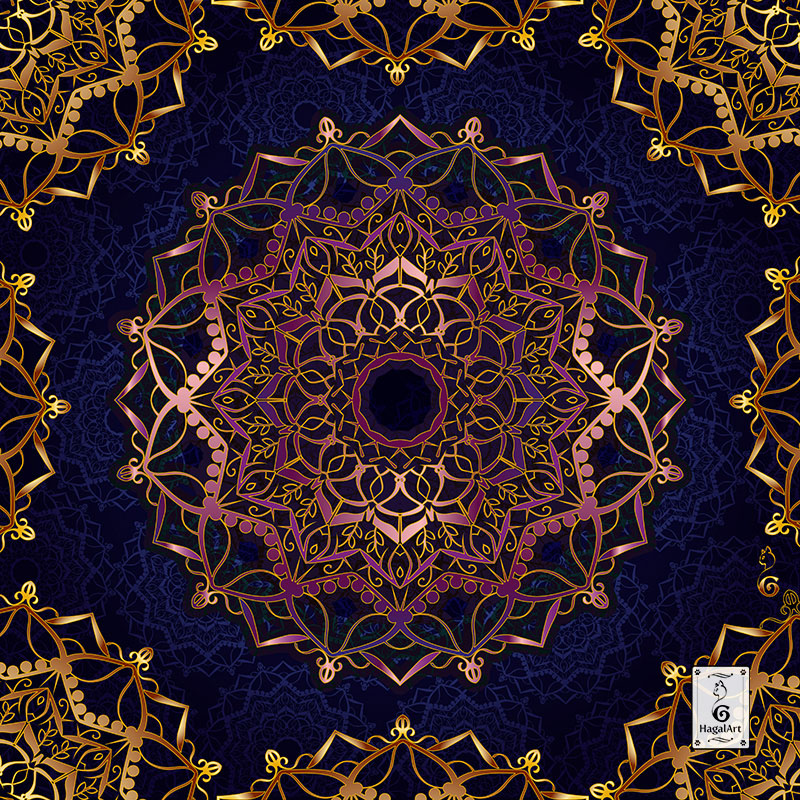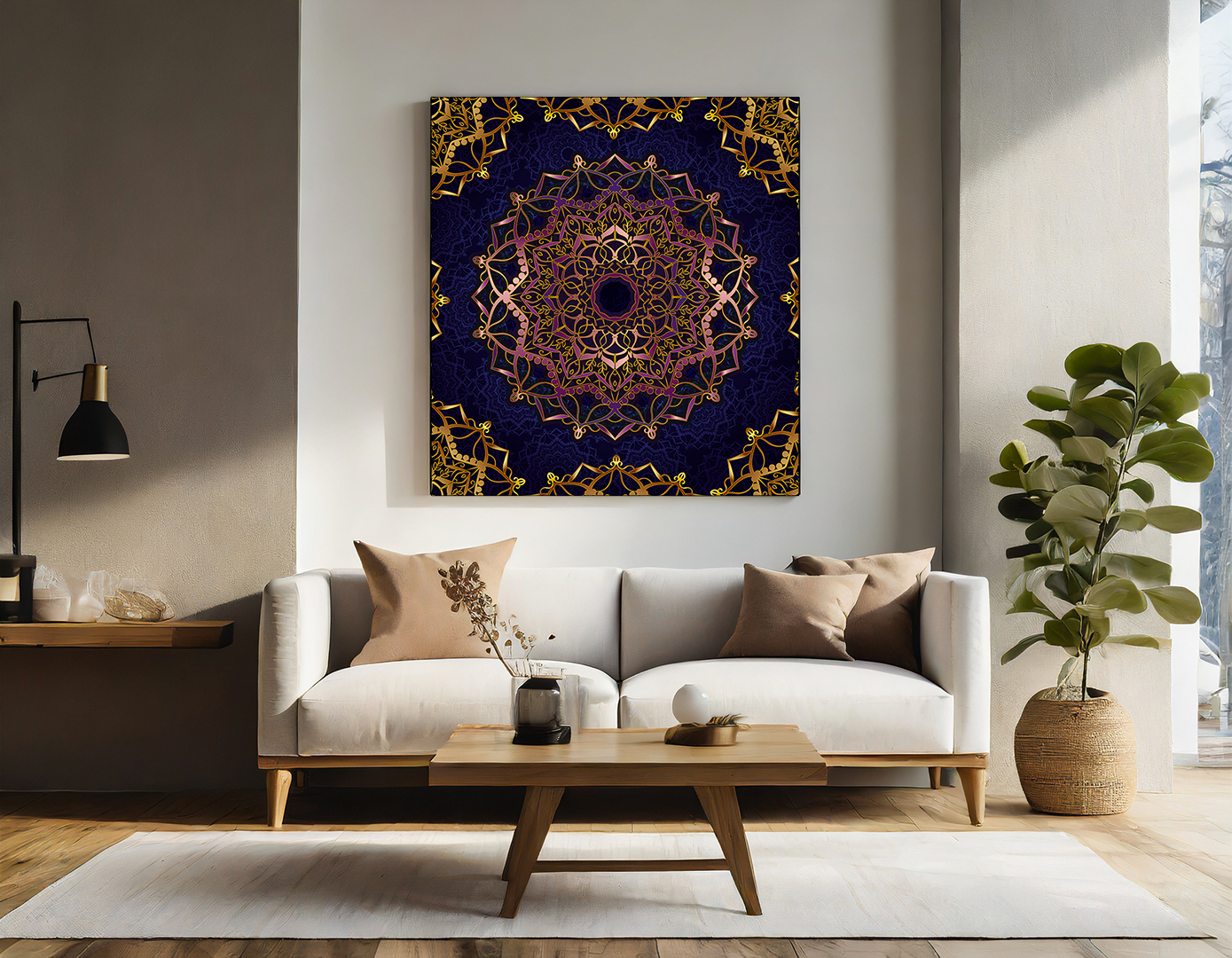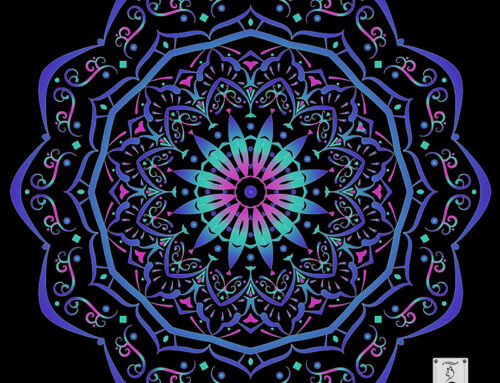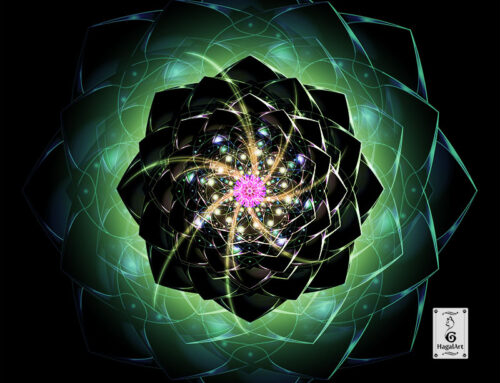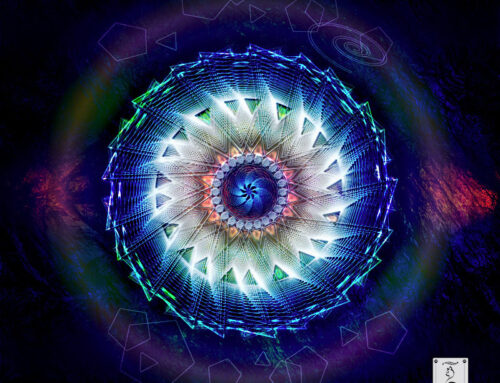“A standard feature of the mandalas created by Giada Zammitti, although and obviously produced in two dimensions, is the prominence of three-dimensionality.
In the case of the “Family” mandala, the three-dimensional constant is profiled by means of a curvilinear network of arabesques that, precisely because of this constant, take on the relief of inlays.
The archetype of this work is the Family, that is, the cornerstone that, since time immemorial and at all Cultures on Earth, has been the foundation of every society.
Starting from the outside, we observe, at the corners, elegant friezes that suggest an indefinite extension beyond the edge of the square, as if to overflow beyond the visible image, and branch out to the entire relational universe outside the family sphere. On either side are four symmetrical scrolls, inspiring stability and harmony.
The central image proceeds inward by successive intertwining patterns, at which leaf-like figures alternate with drop-like ovals.
Approaching the center, the complex weave of the main relationship type of the basic theme prevails: the vertical parental one, and the horizontal one of brotherhood and sisterhood.
Finally, as obvious, the central core, completely black, symbolizing, in this case, the absoluteness of the bond.
Overall, the “Family” Mandala is a graphic synthesis of the inner universe of the basic relationship system of every human being.
Valuable, for anyone who has, or wants to evoke, in rootedness. Most elegant adornment of every domestic hearth.“
WHAT IS A MANDALA
A mandala is a sacred geometric design that originated in ancient religious and spiritual traditions. It is often depicted as a circle with intricate patterns and symbols radiating from the center. The word “mandala” comes from the Sanskrit word for “circle,” and it represents the universe or the sacred space within it.
Mandalas are used as tools for meditation, spiritual reflection, and personal growth. They are believed to help individuals connect with their inner selves, find balance and harmony, and tap into a higher state of consciousness.
The design of a mandala is highly symbolic. The circular shape represents wholeness and unity, reminding us of the interconnectedness of all things. The center of the mandala is considered the focal point, representing the center of our being or the divine essence within us.
Creating or engaging with mandalas can be a transformative practice, offering a pathway to inner peace, self-discovery, and spiritual growth.
“A standard feature of the mandalas created by Giada Zammitti, although and obviously produced in two dimensions, is the prominence of three-dimensionality.
In the case of the “Family” mandala, the three-dimensional constant is profiled by means of a curvilinear network of arabesques that, precisely because of this constant, take on the relief of inlays.
The archetype of this work is the Family, that is, the cornerstone that, since time immemorial and at all Cultures on Earth, has been the foundation of every society.
Starting from the outside, we observe, at the corners, elegant friezes that suggest an indefinite extension beyond the edge of the square, as if to overflow beyond the visible image, and branch out to the entire relational universe outside the family sphere. On either side are four symmetrical scrolls, inspiring stability and harmony.
The central image proceeds inward by successive intertwining patterns, at which leaf-like figures alternate with drop-like ovals.
Approaching the center, the complex weave of the main relationship type of the basic theme prevails: the vertical parental one, and the horizontal one of brotherhood and sisterhood.
Finally, as obvious, the central core, completely black, symbolizing, in this case, the absoluteness of the bond.
Overall, the “Family” Mandala is a graphic synthesis of the inner universe of the basic relationship system of every human being.
Valuable, for anyone who has, or wants to evoke, in rootedness. Most elegant adornment of every domestic hearth.“
WHAT IS A MANDALA
A mandala is a sacred geometric design that originated in ancient religious and spiritual traditions. It is often depicted as a circle with intricate patterns and symbols radiating from the center. The word “mandala” comes from the Sanskrit word for “circle,” and it represents the universe or the sacred space within it.
Mandalas are used as tools for meditation, spiritual reflection, and personal growth. They are believed to help individuals connect with their inner selves, find balance and harmony, and tap into a higher state of consciousness.
The design of a mandala is highly symbolic. The circular shape represents wholeness and unity, reminding us of the interconnectedness of all things. The center of the mandala is considered the focal point, representing the center of our being or the divine essence within us.
Creating or engaging with mandalas can be a transformative practice, offering a pathway to inner peace, self-discovery, and spiritual growth.
“A standard feature of the mandalas created by Giada Zammitti, although and obviously produced in two dimensions, is the prominence of three-dimensionality.
In the case of the “Family” mandala, the three-dimensional constant is profiled by means of a curvilinear network of arabesques that, precisely because of this constant, take on the relief of inlays.
The archetype of this work is the Family, that is, the cornerstone that, since time immemorial and at all Cultures on Earth, has been the foundation of every society.
Starting from the outside, we observe, at the corners, elegant friezes that suggest an indefinite extension beyond the edge of the square, as if to overflow beyond the visible image, and branch out to the entire relational universe outside the family sphere. On either side are four symmetrical scrolls, inspiring stability and harmony.
The central image proceeds inward by successive intertwining patterns, at which leaf-like figures alternate with drop-like ovals.
Approaching the center, the complex weave of the main relationship type of the basic theme prevails: the vertical parental one, and the horizontal one of brotherhood and sisterhood.
Finally, as obvious, the central core, completely black, symbolizing, in this case, the absoluteness of the bond.
Overall, the “Family” Mandala is a graphic synthesis of the inner universe of the basic relationship system of every human being.
Valuable, for anyone who has, or wants to evoke, in rootedness. Most elegant adornment of every domestic hearth.“
WHAT IS A MANDALA
A mandala is a sacred geometric design that originated in ancient religious and spiritual traditions. It is often depicted as a circle with intricate patterns and symbols radiating from the center. The word “mandala” comes from the Sanskrit word for “circle,” and it represents the universe or the sacred space within it.
Mandalas are used as tools for meditation, spiritual reflection, and personal growth. They are believed to help individuals connect with their inner selves, find balance and harmony, and tap into a higher state of consciousness.
The design of a mandala is highly symbolic. The circular shape represents wholeness and unity, reminding us of the interconnectedness of all things. The center of the mandala is considered the focal point, representing the center of our being or the divine essence within us.
Creating or engaging with mandalas can be a transformative practice, offering a pathway to inner peace, self-discovery, and spiritual growth.

